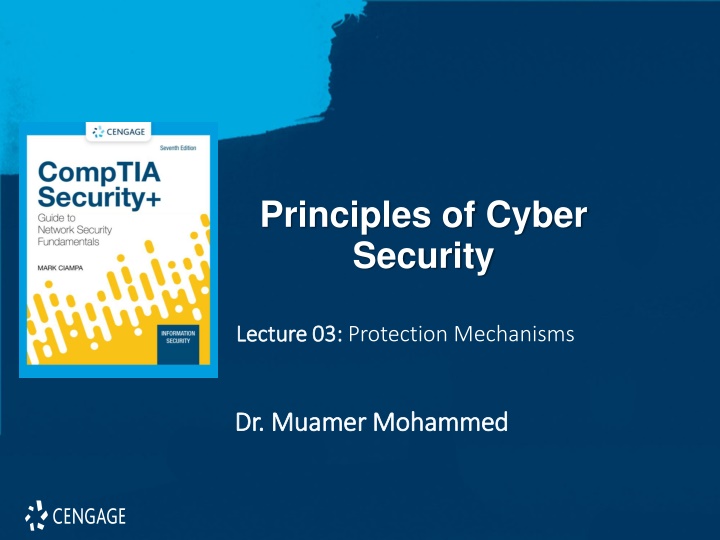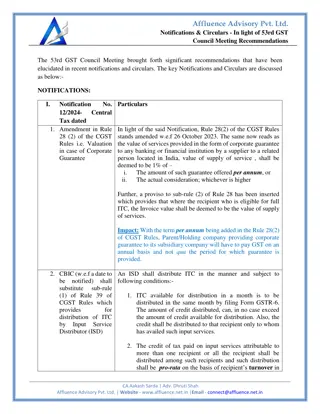
Understanding Cyber Security Protection Mechanisms
Learn about authentication credentials, attacks on authentication, and protection mechanisms in cyber security. Explore various types of authentication credentials such as passwords and smartphone security keys. Understand the importance of multifactor authentication in securing IT environments. Enhance your knowledge to protect against cyber threats effectively.
Download Presentation

Please find below an Image/Link to download the presentation.
The content on the website is provided AS IS for your information and personal use only. It may not be sold, licensed, or shared on other websites without obtaining consent from the author. If you encounter any issues during the download, it is possible that the publisher has removed the file from their server.
You are allowed to download the files provided on this website for personal or commercial use, subject to the condition that they are used lawfully. All files are the property of their respective owners.
The content on the website is provided AS IS for your information and personal use only. It may not be sold, licensed, or shared on other websites without obtaining consent from the author.
E N D
Presentation Transcript
Principles of Cyber Security Lecture 03: Lecture 03: Protection Mechanisms Dr. Dr. Muamer Muamer Mohammed Mohammed 1
Objectives 3.1 Describe the different types of authentication credentials. 3.2 Explain the different attacks on authentication.
Introduction to Protection Mechanisms Technical controls alone cannot secure an IT environment, but they are an essential part of the InfoSec program. Because individuals inside an organization often have direct access to the information, they can circumvent many of the most potent technical controls. 3
Types of Authentication Credentials Somewhere you are Something you are Something you have Someone you know Something you exhibit Something you can do Something you can do 5
Something You Know: Passwords (1 of 2) Passwords are the most common type of IT authentication today Passwords provide only weak protection and are constantly under attack Password Weaknesses Weakness of passwords is linked to human memory Humans can memorize only a limited number of items Long, complex passwords are most effective But they are the most difficult to memorize Users must remember passwords for many different accounts Each account password should be unique 6
Something You Know: Passwords (2 of 2) Password Collections In 2009, an attacker used an SQL injection attack and more than 32 million user passwords (in cleartext) were stolen These passwords gave attackers a large corpus of real-world passwords Using stolen password collections as candidate passwords is the foundation of password cracking today Almost all password cracking software tools accept these stolen wordlists as input 7
Something You Have: Smartphone and Security Keys Multifactor authentication (MFA) is a type of authentication where a user is using more than one type of authentication credential Example: what a user knows and what a user has could be used together for authentication 8
Something You Are: Biometrics (1 of 4) Physiological Biometrics Physiological biometrics uses a person s unique physical characteristics for authentication Several unique characteristics of a person s body can used to authenticate 9
Something You Are: Biometrics (2 of 4) Figure 3-3: Dynamic fingerprint scanner 10
Something You Are: Biometrics (3 of 4) Other human characteristics that can be used for authentication include: A person s vein can be identified through a vein-scanning tablet A person s gait or manner of walking Standard Input Devices Voice recognition uses a standard computer microphone to identify users based on the unique characteristics of a person s voice An iris scanner uses a standard webcam to identify the unique characteristics of the iris Facial recognition uses landmarks called nodal points on human faces for authentication 11
Something You Are: Biometrics (4 of 4) Figure 3-4: Iris 12
Something You Do: Behavioral Biometrics Behavioral biometrics Behavioral biometrics authenticates by normal actions the user performs A type of behavioral biometrics is keystroke dynamics Attempts to recognize user s typing rhythm Keystroke dynamics uses two unique typing variables 13
Summary Authentication credentials can be classified into five categories: what you know, what you have, what you are, what you do, and where you are Passwords provide a weak degree of protection because they rely on human memory Most password attacks today use offline attacks where attackers steal encrypted password file Another type of authentication credential is based on the approved user having a specific item in her possession A hardware token is a small device that generates a code from an algorithm once every 30 to 60 seconds 14
Thank you 15






















